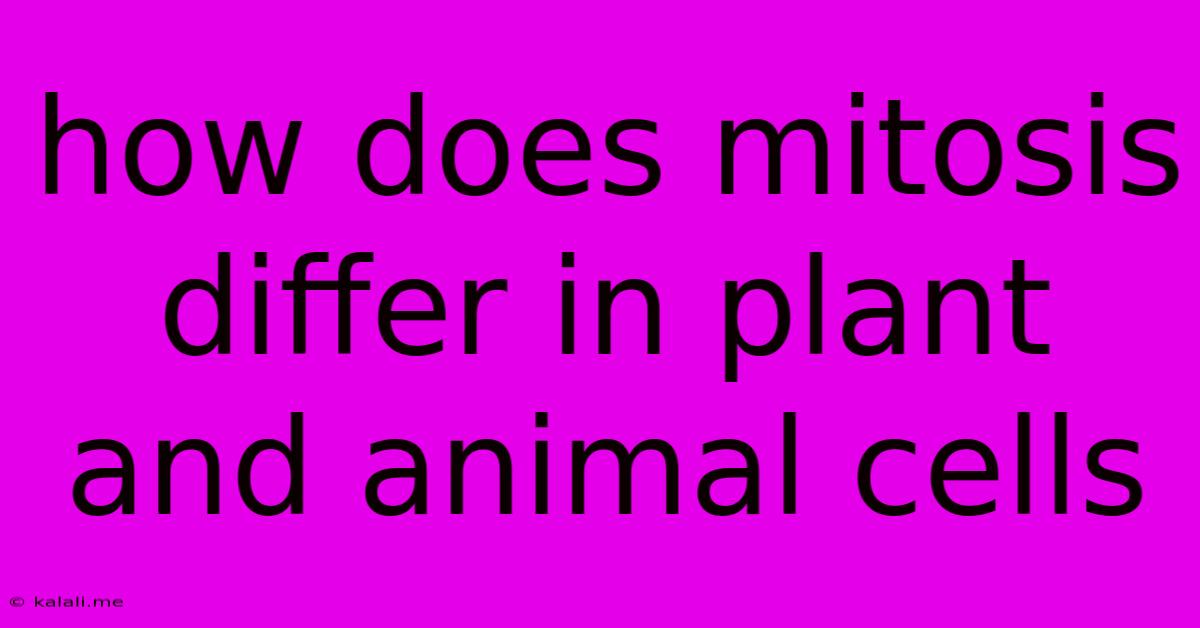How Does Mitosis Differ In Plant And Animal Cells
Kalali
Jun 13, 2025 · 3 min read

Table of Contents
How Does Mitosis Differ in Plant and Animal Cells?
Mitosis, the process of cell division resulting in two identical daughter cells, is fundamental to life. While the core process remains the same across eukaryotes, subtle yet significant differences exist between plant and animal cell mitosis. This article delves into these key distinctions, focusing on cytokinesis – the final stage of cell division – and other notable variations. Understanding these differences provides crucial insight into the cellular mechanisms driving growth and development in different organisms.
Cytokinesis: The Defining Difference
The most striking difference between plant and animal cell mitosis lies in cytokinesis, the physical separation of the two daughter cells. This difference stems from the presence of a rigid cell wall in plant cells, a structure absent in animal cells.
-
Animal Cells: In animal cells, cytokinesis involves the formation of a cleavage furrow. A contractile ring of actin filaments forms beneath the plasma membrane, gradually constricting the cell until it pinches into two separate daughter cells. This process is analogous to tightening a drawstring bag.
-
Plant Cells: Plant cells, encased in their rigid cell walls, cannot undergo cytokinesis via cleavage furrow formation. Instead, a cell plate forms in the center of the cell. This cell plate, derived from Golgi vesicles containing cell wall materials (like cellulose and pectin), grows outwards until it fuses with the existing cell wall, effectively dividing the cell into two. The cell plate eventually matures into a new cell wall separating the daughter cells.
Other Notable Differences
Beyond cytokinesis, several other subtle differences distinguish plant and animal cell mitosis:
-
Preprophase Band: In plant cells, a preprophase band of microtubules forms before the nuclear envelope breaks down. This band marks the future site of the cell plate, guiding the precise positioning of the division plane. This structure isn't observed in animal cell mitosis.
-
Phragmoplast: During plant cell cytokinesis, a phragmoplast, a structure of microtubules and other proteins, forms between the two daughter nuclei. This structure guides the Golgi-derived vesicles containing cell wall materials to the cell plate, facilitating its formation and expansion. No equivalent structure exists in animal cells.
-
Spindle Organization: While both plant and animal cells use a mitotic spindle to separate chromosomes, the organization of the spindle can differ slightly. In animal cells, the centrosomes (which contain centrioles) play a crucial role in organizing the spindle poles. Plant cells, while having microtubule organizing centers, generally lack centrioles. Spindle formation occurs, but it is initiated in a slightly different manner.
-
Cell Wall Formation: The formation of a new cell wall between daughter plant cells is a unique feature absent in animal cell mitosis. This cell wall construction is critical for maintaining cell structure and integrity in plants.
Conclusion
While the fundamental steps of mitosis—prophase, prometaphase, metaphase, anaphase, and telophase—are conserved in both plant and animal cells, the process of cytokinesis and other associated events show marked differences. These differences reflect the unique structural and functional requirements of plant and animal cells, highlighting the remarkable adaptability of mitosis in diverse eukaryotic organisms. Understanding these differences is fundamental to comprehending the mechanisms of cell division and its significance in growth, development, and overall organismal biology.
Latest Posts
Latest Posts
-
What Are All The Multiples Of 7
Jun 14, 2025
-
What Is Square Root Of 61
Jun 14, 2025
-
What Do Plants Store Glucose As
Jun 14, 2025
-
Least Common Multiple Of 4 6 7
Jun 14, 2025
-
Emotional Intelligence Questions And Answers Pdf
Jun 14, 2025
Related Post
Thank you for visiting our website which covers about How Does Mitosis Differ In Plant And Animal Cells . We hope the information provided has been useful to you. Feel free to contact us if you have any questions or need further assistance. See you next time and don't miss to bookmark.